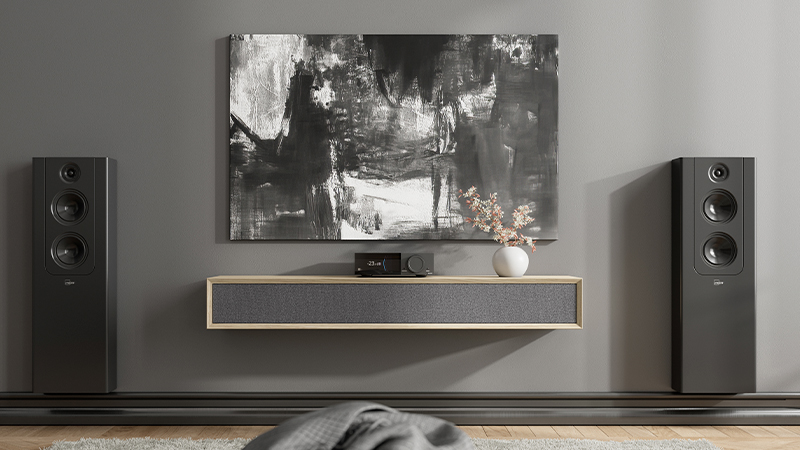The streaming integrated amplifier market is flooded with similar products that differ only in branding. Most offer the same connectivity, comparable power ratings, and basic room correction wrapped in slightly different packages. I’ve reviewed several that actually stand out: the Cambridge Audio EVO 150, the Marantz Model M1, and the Bluesound Powernode N331.
The Lyngdorf TDAI-2210 is another exception. Announced in May, I got hands-on time with it last week, and after testing it with various speakers, this is something different. This Danish-manufactured streaming amplifier sits in the middle of Lyngdorf’s three TDAI models and features a new color touchscreen, the company’s unique Equibit digital amplification, and the renowned RoomPerfect™ room correction system.
Design And Build Quality
The Lyngdorf TDAI-2210’s compact aluminum chassis feels substantial despite measuring just 12.8 inches wide; it is significantly smaller than most of the amplifiers out there. It delivers 105 watts per channel into 8 ohms and 210 watts per channel into 4 ohms. The matte black finish (silver is also available) looks simple next to flashier competitors, but that restraint works in its favor.
The front panel’s color touchscreen dominates the face, displaying album art and system info clearly from across the room. The volume wheel beside it has the precise, weighted feel you’d expect at this price point, no cheap plastic here. Unlike most integrated amps, where volume control happens early in the signal chain, the TDAI-2210 adjusts gain at the output stage, maintaining sound quality even at low volumes.
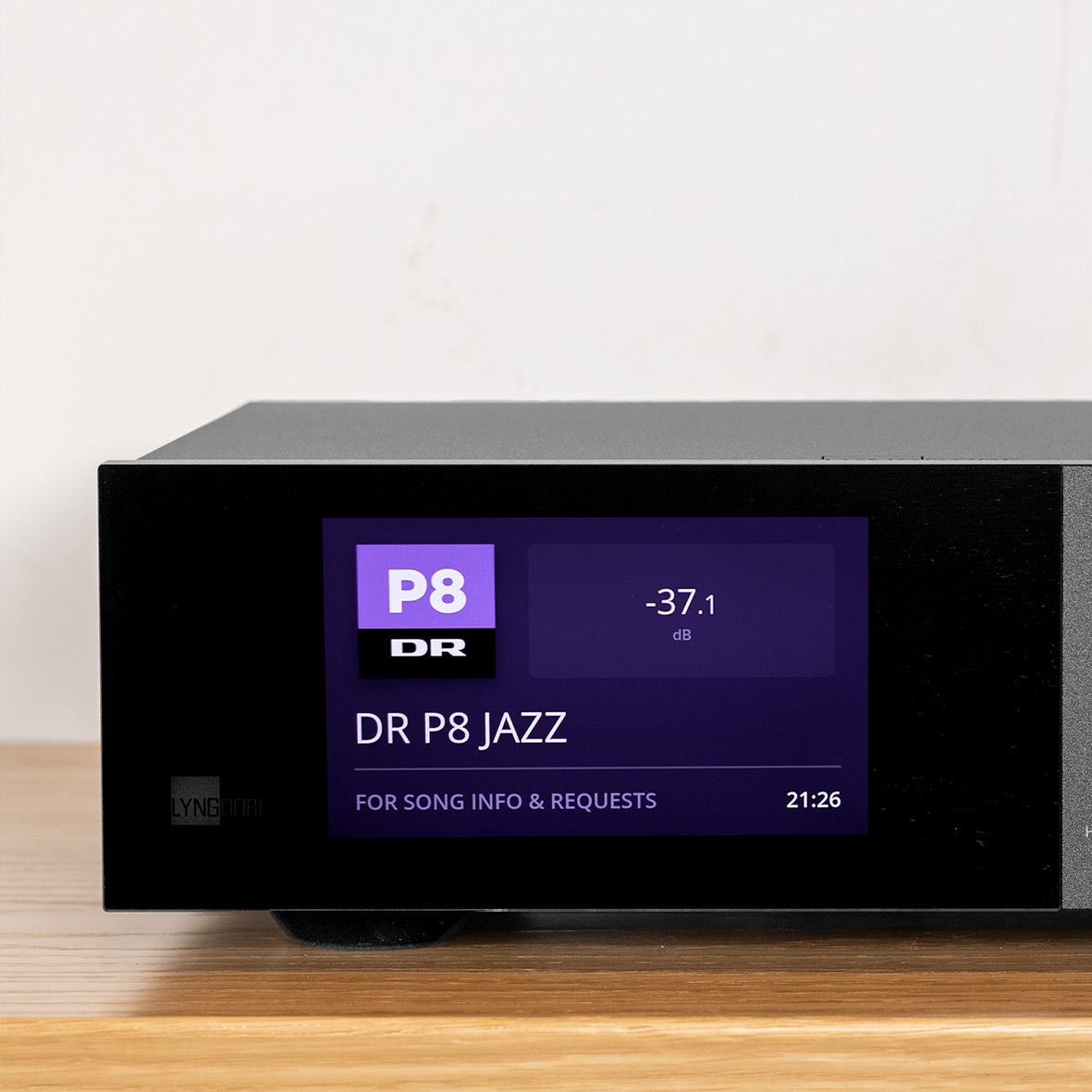
On the back panel, connectivity is comprehensive: USB-C, HDMI eARC, three coaxial and two optical digital inputs, plus two analog RCA inputs. Outputs include RCA, balanced XLR, coaxial digital, and a front-panel 3.5mm headphone jack.
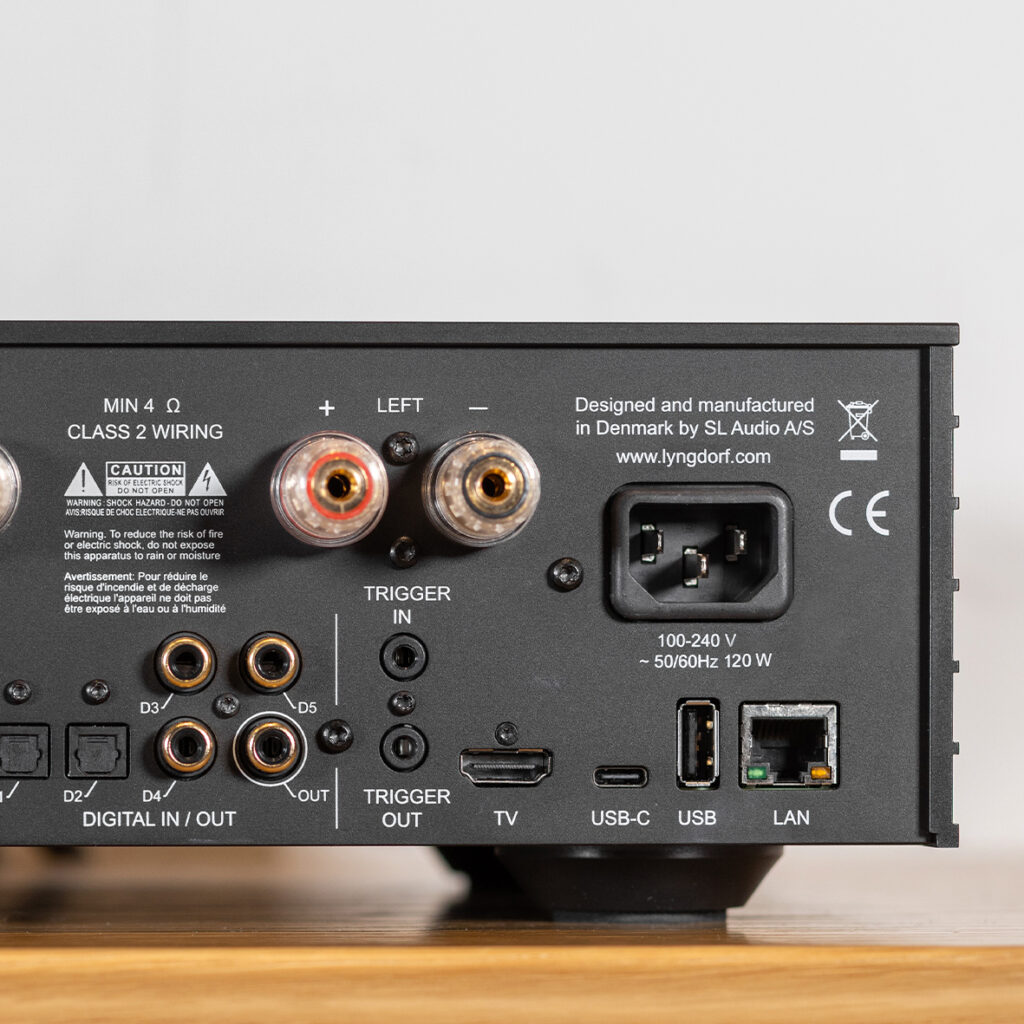
The base model of the Lyngdorf TDAI-2210 retails for $4499, and the optional modular slot lets you add either a high-end analog module with a phono stage or additional HDMI inputs later. The phono module adds a Moving Magnet phono stage along with one balanced XLR input and two RCA inputs, and the HDMI 2.1 module adds two additional HDMI inputs and one output that supports 8K and 4K passthrough. The phono module brings the price up to $5049, while the HDMI module makes it $5149. We first saw modular upgrades in the Moonriver 404 Reference, and I’m glad other companies are catching on.
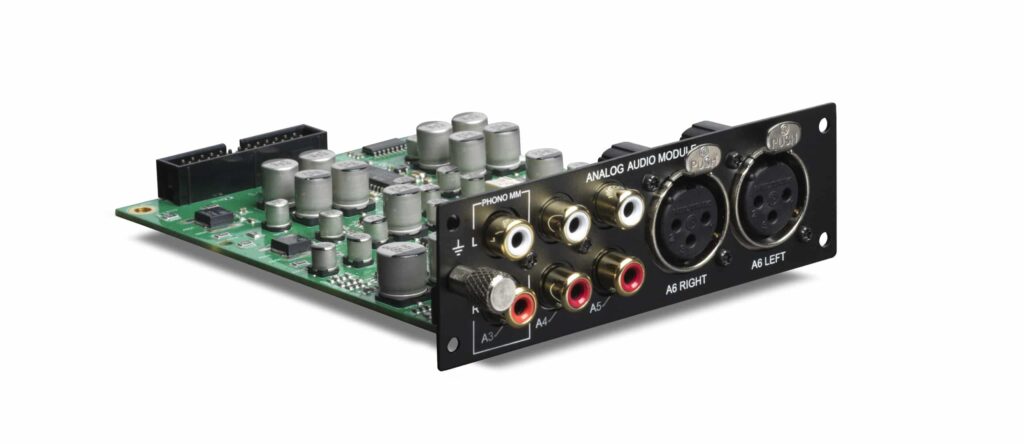
Equibit Digital Amplification
The TDAI-2210’s Equibit amplification caught my attention because it eliminates the usual digital-to-analog conversion step entirely. Most integrated amps, even expensive ones, convert your digital files to analog, process them, then back to digital for Class D switching. The Lyngdorf skips that middle step.
In practice, this means when I’m streaming a 24/192 file from Qobuz, that resolution stays intact all the way to the output stage. No degradation from multiple conversions. The difference becomes obvious during quiet passages, there’s just more space between instruments, less of that digital ‘haze’ you get from lesser amplifiers. The only conversion happens with analog sources, where a single high-quality ADC brings everything into the digital domain.
RoomPerfect Room Correction
Almost all the other streaming amps and companies in general use Dirac or Audyssey for room correction. Lyngdorf went ahead and made their own software, which they call RoomPerfect. It is a good option for beginners, and certainly easier to use than Dirac or Audyssey. Also, RoomPerfect is free to use with all Lyngdorf products, while Dirac and Audyssey require you to buy a license.
Using the microphone that comes with the TDAI-2210, RoomPerfect maps out your room and focuses on the power response. It takes over two million measurements using sound reflections and tries to fix the problems you would face with your audio setup. It uses the microphone to take measurements from your primary listening position, and then it takes multiple measurements from all around the room. It then calibrates your sound so that you get the best experience from your primary listening position and improves the overall sound balance in your room.
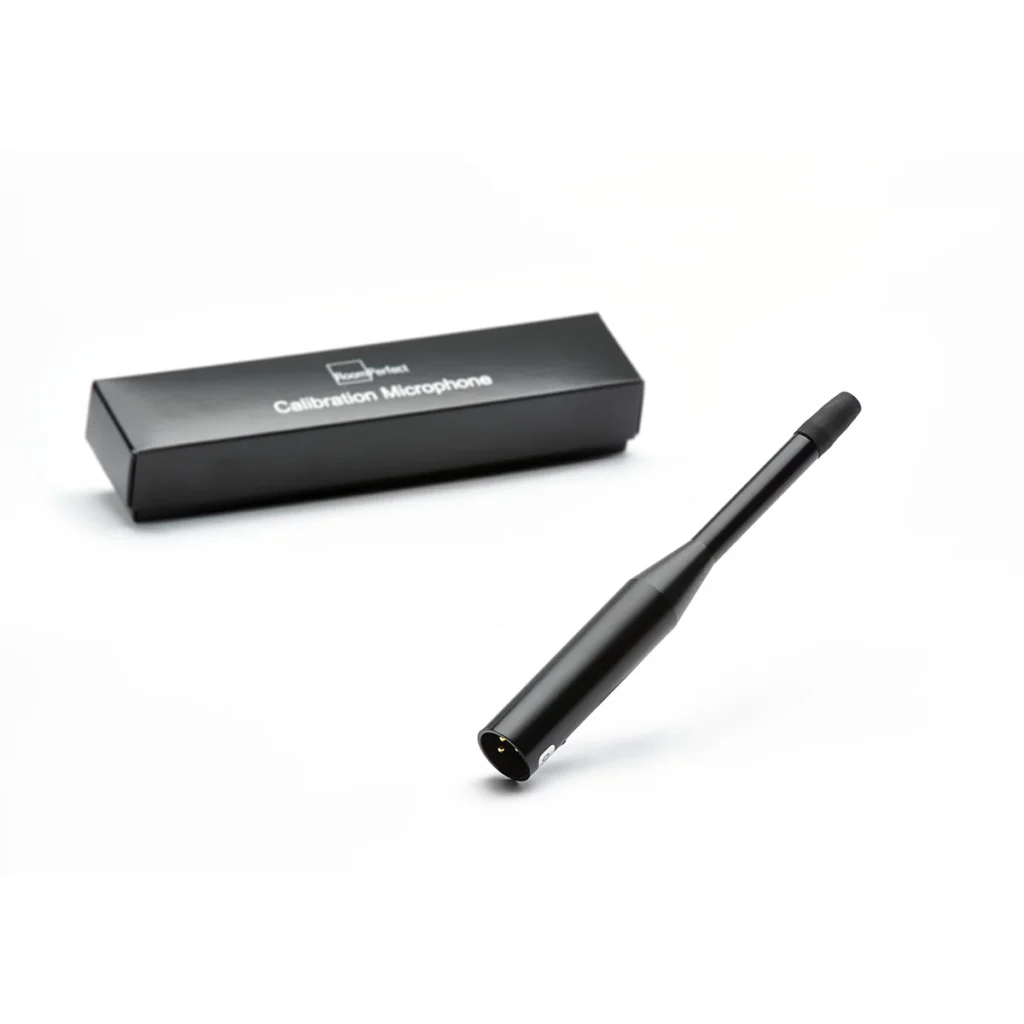
All of this process is automated, and you just have to move your microphone around your room when prompted. Once calibrated, you get performance that is more precise to your listening position, it has better imaging, and it is more natural, no matter what room constraints you have. It also calibrates other components in your setup, like a subwoofer. It integrates seamlessly, and it improves the subwoofer’s timing.
The Streamer Section
The Lyngdorf TDAI-2210 supports Tidal Connect, Spotify Connect, Qobuz Connect (finally), Chromecast, Bluetooth, Apple AirPlay, DLNA, and it is Roon Ready. You can connect a USB and stream from it, and you can also play tracks directly over your network.
You can control the streaming amp from your phone with the My Lyngdorf app. The My Lyngdorf app handles everything you’d normally need a web browser for, speaker setup, RoomPerfect calibration, all that stuff. They ditched a menu-heavy interface for simple icons, which honestly makes it much easier for you to navigate through the app. The keyword here is customization; you can rearrange the layout however you want, rename your inputs, and hide the functions you won’t use. The voicing adjustments show you little graphs of what each setting does to the sound, and the radio search is surprisingly decent. Instead of scrolling through random stations, you just tell it you want jazz from Europe it finds relevant options. It also shows you the actual bit rate and sample rate of what you’re streaming.
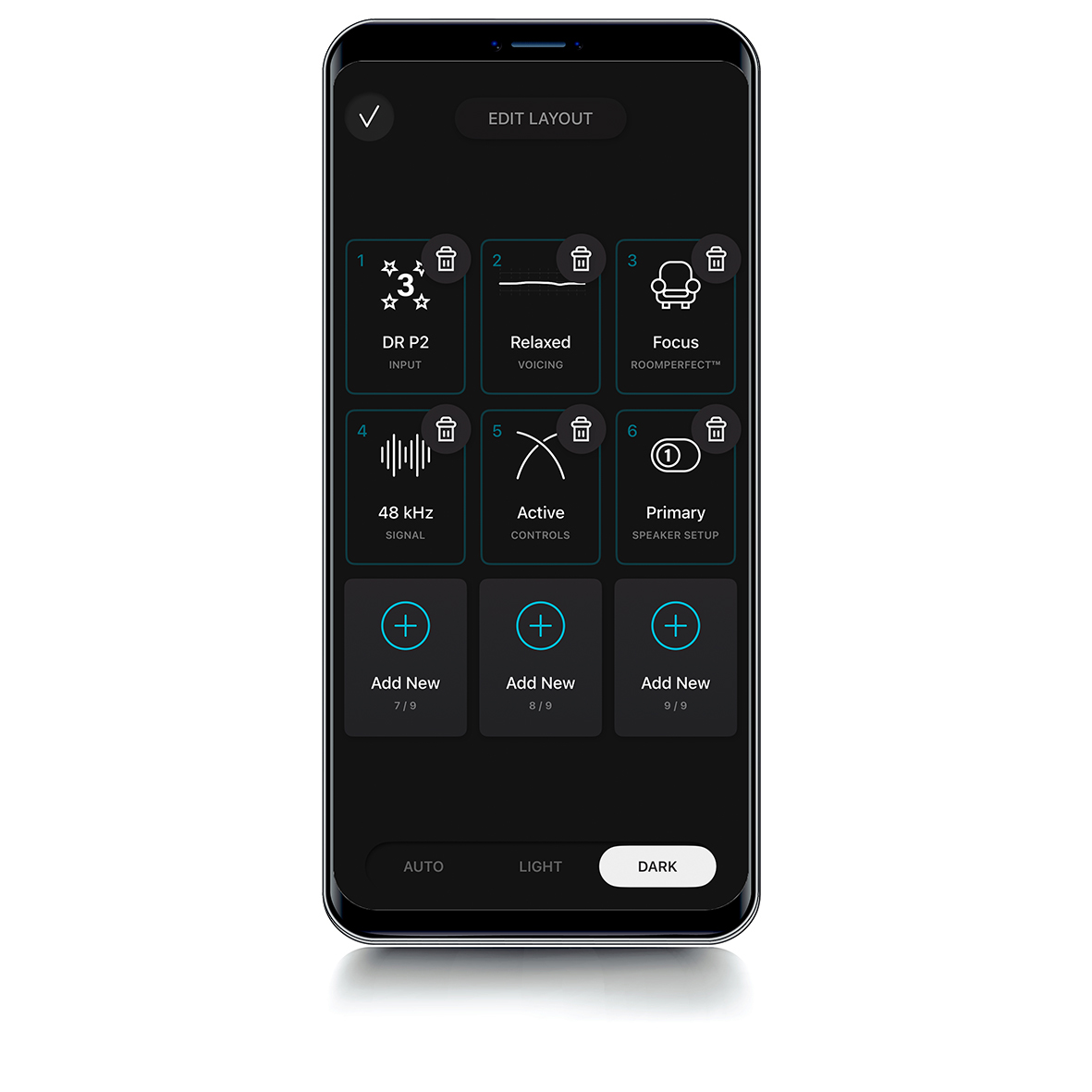
One thing I use all the time, you can set a favorite radio station to automatically power everything on. Just tap that station and both the amp and music start up. It’s not that special, but it’s handy when you want background music without thinking about it.
Sound Quality
The Lyngdorf TDAI-2210 delivers sound that feels effortless rather than forced. Put on something like Pink Floyd’s “Wish You Were Here” and you immediately notice how much space exists between instruments, there’s air and separation that makes everything feel more natural. Arctic Monkeys’ “Do I Wanna Know?” has layers of guitars, bass, and drums that can sound muddy on some systems, but the 2210 kept each element distinct without making anything sound over-processed.
Post Malone’s “Circles” can sound compressed and lifeless on some systems, but the TDAI-2210 gave his vocals room to breathe while keeping the electronic elements crisp and defined. AC/DC’s “Thunderstruck” is a good test for any amp’s dynamics; those guitar hits need to snap. The 2210 delivered that punch while keeping Malcolm Young’s rhythm guitar distinct from Angus’s lead work. Everything had its place in the mix; no instrument felt out of order.
After running RoomPerfect, the soundstage opened up significantly. My listening room isn’t ideal; it’s got hardwood floors and minimal treatment, but the calibration managed to correct some nasty reflections and tighten up the bass response without making everything sound over-corrected.
The Lyngdorf TDAI-2210 never feels like it’s working hard, even with demanding material. The Danish engineering shows through in how composed everything stays, regardless of what you throw at it.
Verdict: Should You Get The TDAI-2210 Streaming Amplifier?
The Lyngdorf TDAI-2210 sits in a tough spot at $4,499. You’re paying premium money for a streaming amp that needs to justify its price against some strong competition. After spending time with it, I think it does.
Why do I like it? It’s how everything works together. The Equibit amplification genuinely sounds different from typical Class D designs, RoomPerfect actually fixed room problems instead of just applying generic EQ curves, and the build quality feels like it’ll last decades. The modular upgrade system is smart, too. Start with the base unit and add the phono stage or HDMI module when you need them, rather than paying upfront for features you might not use.
Where it falls short: the price puts it against some serious competition, and if you don’t care about room correction, you can get similar power and streaming features for less. The touchscreen is nice but not essential, and some people prefer physical buttons, myself included.
Specifications
Description: 2-channel integrated streaming amplifier
Power rating: 2 x 210 W @ 4Ω / 2 x 105 W @ 8 Ω
Idle power consumption: 18-26 W
Standby power consumption: < 0.5W
Max output current per channel: 35A
Audio specifications: Frequency Response: ±0,5dB from 20 – 20,000 Hz, Total Harmonic Distortion: 0.05% max from 20 – 20,000Hz, THD-N 1w/8ohm 0,04%, THD-N 1w/4ohm 0,04%
Digital inputs: 3 x Coaxial digital (≤192kHz / 24 bit), 2 x optical digital (≤ 96kHz / 24 bit), 1 x USB C (≤192kHz / 24 bit), 1 x HDMI 2.1 eARC (≤192kHz/24bit)
Digital output: 1 x Coaxial digital (96kHz / 24 bit)
Analog inputs: 2 x Single Ended RCA, 1 x Mic input (XLR) for RoomPerfect™
Analog outputs: 1 x Single Ended RCA, 1 x XLR Balanced, 1 x 3.5mm headphone
High-End analog module (optional): 1 x RIAA Phono MM, 2 x single ended RCA, 1 x XLR balanced
HDMI 2.1 module (optional): 1 x HDMI Output / 2 x HDMI Inputs (PCM ≤192kHz/24bit), eARC/ARC (PCM ≤192 kHz/24bit), CEC integration
EQ: RoomPerfect™, voicings, Bass/Treble tone controls
Media player: Internet Radio (Airable), Spotify Connect, TIDAL Connect, Roon Ready, Google Chromecast, Apple AirPlay 2, DLNA Support (UPnP/see DLNA formats), Local file playback (USB), Bluetooth (BLE), Plays with Audirvana
Interfaces: Touchscreen, web-interface for setup and media player, remote application for IOS and Android, IP control, CEC (HDMI), 1 x trigger input, 1 x trigger output, 1 x RJ45 Ethernet LAN
Remote control: Infrared or Bluetooth
Accessories included: RoomPerfect™ microphone with stand and cable, Remote control
Dimensions (W x H x D): 325 x 102 x 300 mm (incl. connections) / 12.8 x 4 x 11.8 inches (incl. connections)
Weight: 4,8 kg / 10,6 lb
Finish: Matte black
Available versions: TDAI-2210, TDAI-2210 + High-End Analog Module, TDAI-2210 + HDMI 2.1 Module
Price
$4499
